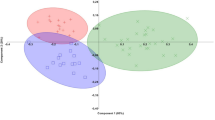Abstract
After replacing sand, a natural component of the endogenous otolithic apparatus of the Cuban crayfishProcamabrus cubensis by particles of reducible iron and subsequent exposure of the animals to a constant magnetic field, the following changes were noted in their behavior: during the first 24 h the motor activity of the animals increased and was accompanied by frequent strong beats of antennulae on water; animals tried to go away from the magnet attached to the aquarium wall and to hide in a shelter; by the day 10—12, there appeared signs of adaptation to the action of magnet; the animals spent most time near the wall with the magnet and were clinging close to it. If the magnet was moved the animals not only slipped to their side but also rotated around their longitudinal axis. The eyestalks also started moving. After molt and repeated introduction of reduced iron particles into the statocysts, a negative reaction to magnet was practically absent, and the crayfish preferred staying near the magnet. Study of structural organization of the statocysts under a scanning electron microscope showed that the iron particles in the otolithic apparatus of the crayfish are covered with a thinner layer of glycocalyx as compared to control animals whose otolithic apparatus is composed of sand grains. Besides, the otolithic apparatus of the experimental animals is a loose formation, unlike the dense glycocalyx rich in conglomerate in control animals.
Similar content being viewed by others
References
Kharkeevich, T.A., Lebskii, V.K., and Lavrova, E.A., Statocyst of the Crayfish by the Data of Scanning Electron Microscopy,Sensorn. Systemy, 1989, vol. 3, pp. 117–124.
Kharkeevich, T.A., Investigation of the Gravity Receptor ofAstacus astacus (Crustacea, Decapoda): Development and Behavioral Data,Z. mikrosk. Anat. Forsch., Leipzig, 1990, vol. 104, pp. 639–649.
Kovalev, V.A. and Kharkeevich, T.A., Study of Peculiarity of the Morphofunctional Organization of the Receptor Apparatus of the Statocyst of the Crayfish,Procambarus cubensis, Zh. Evol. Biokhim. Fiziol., 1993, vol. 29, pp. 142–149.
Shuranova, Zh.P. and Burmistrov, Yu.M.,Neirofiziologiya rechnogo raka (Crayfish Neurophysiology), Moscow, 1988.
Kharkeevich, T.A., Study of Ultrastructural Organization of the Statocyst of the Mysids,Mysis oculata, Tsitologiya, 1983, vol. 25, pp. 1145–1155.
Vinnikov, Ya. A., Gazenko, O.G., Titova, L.K.,et al., Retseptor gravitatsii (Gravitational Receptor), Leningrad, 1971.
Kreidl, A., Weitere Beitrage zur Physiologie des Ohrlabyrinthes (11 Mitth). Versuche an Krebsen,Sizberich. Acad. Wiss. Abt., 1893, vol. 3, no. 102, p. 149.
Lemmnitz, G. and Wolf, H.G., Recording from Sensory Cells in the Statocyst ofAstacus, Frontiers in Crustacean Neurobiology, Advances in Life Sciences, Birkhauser Verlag Basel, 1990, pp. 97—105.
Kharkeevich, T.A., Structure of Macula of the Statocyst of the Cuban Crayfish,Procambarus cubensis, Zh. Evol. Biokhim. Fiziol., 1994, vol. 30, pp. 607–612.
Author information
Authors and Affiliations
Rights and permissions
About this article
Cite this article
Kharkeevich, T.A., Gorgiladze, G.I. Morphofunctional study of the statocyst of the Cuban crayfish Procambarus cubensis . J Evol Biochem Phys 36, 71–77 (2000). https://doi.org/10.1007/BF02738229
Received:
Issue Date:
DOI: https://doi.org/10.1007/BF02738229




